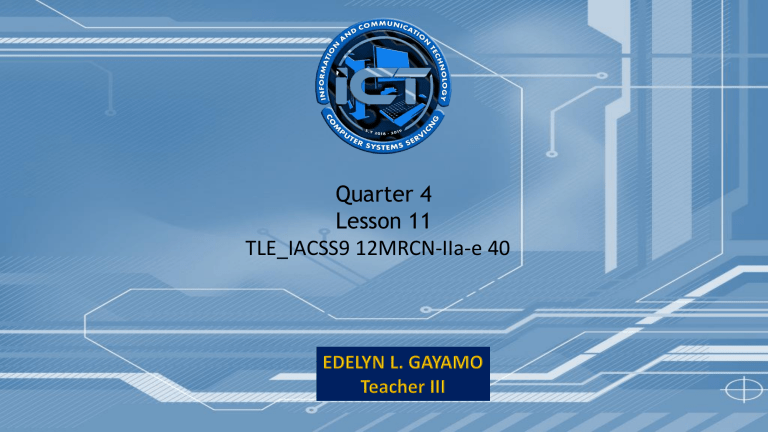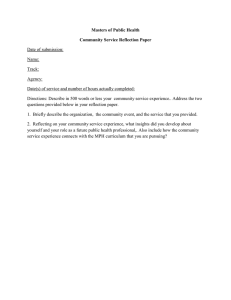
Quarter 4 Lesson 11 TLE_IACSS9 12MRCN-IIa-e 40 Prayer Checking of Attendance Class Rules Checking of Attendance April 22, 2024 1:00-2:00 PM Total No. of Learners: 39 Present: Absent: What you already know? Elicit TRUE or FALSE FALSE _____1. A multimeter is used primarily for testing electrical circuits. TRUE _____2. A cable tester is used to determine the continuity and faults in network cables. FALSE _____3. A screwdriver is suitable for crimping network cables. _____4. TRUE An anti-static wrist strap is used to prevent electric shocks to computer components during maintenance. FALSE _____5. A network analyzer is primarily used for measuring voltage in computer systems. Objectives of the Lesson: 1. Identify essential tools and test equipment used in computer system and network maintenance. 2. Understand the functions and purposes of each tool in diagnosing and repairing computer systems. 3. Demonstrate proper usage and safety precautions when handling tools and test equipment. Engage Imagine you are tasked with diagnosing a network issue in a large office environment where multiple computers are experiencing connectivity problems. How would you approach this situation using the tools and test equipment? Mastermind World Explore Mastermind World Explore Mastermind World Explore Mastermind World Explore Explore GROUP 1 A network cable is suspected to be faulty, causing intermittent connectivity issues for a computer. :_____________ Explore GROUP 2 A computer is not powering on, and the power supply is suspected to be faulty. :_____________ Explore GROUP 3 A server in the network is experiencing slow response times, affecting user access to shared resources. :_____________ Explore GROUP 4 A computer is displaying error messages related to hardware issues. :_____________ Explore GROUP 5 In a computer maintenance workshop, cables are often scattered and disorganized, making it difficult to identify connections and troubleshoot effectively. During a routine check, a technician notices that the network cables in a server rack are tangled and loosely hanging, posing a risk of accidental disconnection and signal interference. :_____________ Explain Elaborate Group Activity 1. Assign each group with specific tools to research further. 2. Have each group present their findings, including additional features, advanced usage, and best practices. GROUP 1: Electro-Static Discharge Tools (ESD) (2) GROUP 2: Computer Hand Tools (4) GROUP 3: Computer Cleaning Tool (3) GROUP 4: Diagnostic Tools (2) Extend ADVANCED TOOLS AND TEST EQUIPMENT A network analyzer, also known as a network protocol analyzer or packet analyzer, is a specialized tool used in networking to monitor, capture, analyze, and troubleshoot network traffic and protocols. Its primary purpose is to provide detailed insights into network performance, diagnose network issues, and optimize network efficiency. Extend ADVANCED TOOLS AND TEST EQUIPMENT An oscilloscope is a versatile electronic test instrument used in various fields, including electronics, telecommunications, engineering, and physics. Its primary purpose is to visualize and analyze the waveform of electrical signals over time. Extend ADVANCED TOOLS AND TEST EQUIPMENT A cable certifier is a specialized tool used in networking and telecommunications to certify the performance and compliance of network cables. Its primary purpose is to ensure that installed cables meet industry standards and are capable of supporting highspeed data transmission without errors or signal degradation. Evaluate REFLECTION Direction: Please provide a possible solution/s to the situations given. 1. Describe a real-world network troubleshooting scenario where you would use specific tools and test equipment discussed in class. 2. Analyze a captured waveform or network packet using an oscilloscope or network analyzer. Describe the key parameters you would examine, such as amplitude, frequency, timing, or protocol details. REFLECTION Evaluate Possible Solutions: 1. Implementing Solutions: Implement corrective measures based on the identified root causes, such as optimizing network settings, updating firmware, or replacing faulty hardware components. Configure Quality of Service (QoS) settings to prioritize critical traffic and improve overall network performance. Conduct thorough testing and monitoring to ensure that the implemented solutions resolve the connectivity issues effectively. 2. Packet Capture and Import: Start by importing the captured packet file (.pcap or .cap format) into the network analyzer software for analysis. Ensure that the software is configured to display relevant protocol details, packet headers, payload data, and timing information. RUBRICS FOR REFLECTION CRITERIA Depth of reflection Connection to Learning EXCELLENT (4) PROFICIENT (3) BASIC (2) LIMITED (1) Demonstrates a profound and insightful reflection on personal experiences, thoughts, and feelings. Clearly goes beyond surfacelevel observations. Presents a thoughtful reflection that explores personal experiences, thoughts, and feelings in a meaningful way. Provides a basic reflection on personal experiences, thoughts, and feelings. Some depth, but lacks thorough exploration. Offers a limited reflection that lacks depth and fails to explore personal experiences, thoughts, and feelings in a meaningful way. Clearly articulates how the reflection connects to the learning process. Highlights specific insights gained and lessons learned. Provides a solid connection between the reflection and the learning process. Describes insights and lessons learned with some clarity. Makes a basic connection between the reflection and the learning process. Generalizes insights and lessons learned. Fails to establish a clear connection between the reflection and the learning process. Lacks specificity in insights and lessons learned.


